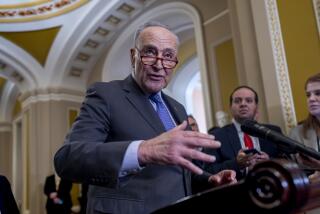Defense Industry Barely Nicked by Budget Accord
The defense industry faces painful and long-term cutbacks over the next several years, but the agreement between the White House and congressional leaders to cut the budget deficit does nothing to further darken expectations.
Top industry leaders were still trying to understand all of the ramifications of the budget deal, but the overall numbers seemed to underscore one major point: that the Persian Gulf crisis has noticeably slowed the movement to cut the defense budget.
“We were headed toward significant cuts on the assumption that we had no enemies in the world,” Prudential Bache aerospace analyst Paul Nisbet said Monday. “That utopian view of the world has been dashed to pieces.”
Congressional authorizations and appropriations will be made later this year, determining the fate of such key programs as the Northrop B-2 bomber and the McDonnell Douglas C-17 cargo jet, both of which are critical to their companies and are major Southern California employers.
Such specific programs were not included in Sunday’s budget agreement, which still must be approved by Congress.
To the amazement of some analysts, the budget accord will increase Pentagon spending by several billion dollars in fiscal 1991, compared to the level that Congress was likely to authorize.
Moreover, that increase in Pentagon spending does not include the estimated $15 billion for the Persian Gulf crisis. If that amount were included in the Pentagon budget, spending would grow to $303.5 billion, just short of the original Bush Administration proposal earlier this year.
Under the budget agreement, the Pentagon will separately receive $288.5 billion in budget authority during 1991. By comparison, the House had authorized only $283 billion and the Senate $289 billion, a difference that was likely to be compromised at some midpoint. Thus, the Pentagon is likely to receive several billion more under the budget accord than it was under a compromise of the earlier House and Senate authorizations.
Nisbet estimates that the eruption of the Persian Gulf crisis has resulted in a $20-billion windfall of additional funding for the Pentagon during the fiscal year that started Monday. “If the Persian Gulf crisis goes away, and everybody forgets this can be a nasty world, then we could go back to cutting the budget,” he said. “But that is a lot of ifs , and history does not bear out those assumptions.”
But other analysts continue to expect a protracted downturn in defense spending.
“I don’t think this budget accord will affect the defense budget any more greatly then what I expected before the compromise,” said Ron Hertenstein, vice president for Forecast Associates, a Newtown, Conn.-based aerospace market research firm. “Cutting defense didn’t have anything to do with the Persian Gulf. It had to do with Europe, and that is proceeding as we expected. The forces planned in the budget should be sufficient for Desert Shield-type operations.”
Indeed, the budget accord provides for a sustained decline in Pentagon spending. It would drop by $35.1 billion by 1992, $47.2 billion by 1993, as much as $58.6 billion by 1994 and as much as $69.6 billion by 1995.
That scenario would depress Pentagon spending by nearly 25% by the mid-1990s, a prospect for which the defense industry has been well prepared during much of this year and a vastly better outcome than the Draconian 50% cutbacks proposed by some reformers.
“You can still have national security (under the long-term cutbacks), as long as you don’t have a major nuclear threat or a major conventional conflict,” Hertenstein said.
Most analysts, however, say the projections beyond 1991 have little credibility because the budget accord does not mandate the cutbacks and future Congresses may not even remember what was agreed upon.
Information about specific programs will not come until the House and Senate compromise on their earlier authorization bills.
More to Read
Sign up for Essential California
The most important California stories and recommendations in your inbox every morning.
You may occasionally receive promotional content from the Los Angeles Times.











